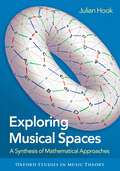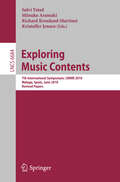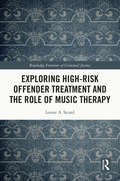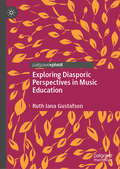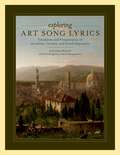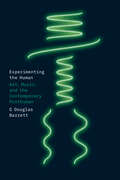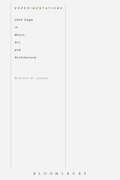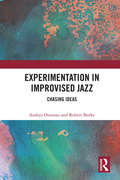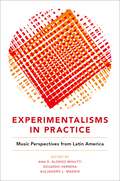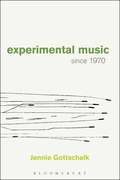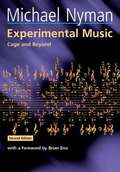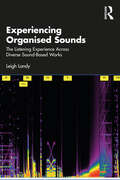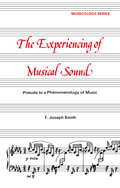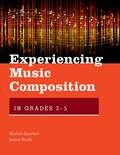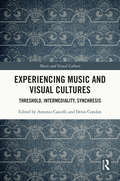- Table View
- List View
Exploring Musical Spaces: A Synthesis of Mathematical Approaches (Oxford Studies in Music Theory)
by Julian HookExploring Musical Spaces is a comprehensive synthesis of mathematical techniques in music theory, written with the aim of making these techniques accessible to music scholars without extensive prior training in mathematics. The book adopts a visual orientation, introducing from the outset a number of simple geometric modelsthe first examples of the musical spaces of the book's titledepicting relationships among musical entities of various kinds such as notes, chords, scales, or rhythmic values. These spaces take many forms and become a unifying thread in initiating readers into several areas of active recent scholarship, including transformation theory, neo-Riemannian theory, geometric music theory, diatonic theory, and scale theory. Concepts and techniques from mathematical set theory, graph theory, group theory, geometry, and topology are introduced as needed to address musical questions. Musical examples ranging from Bach to the late twentieth century keep the underlying musical motivations close at hand. The book includes hundreds of figures to aid in visualizing the structure of the spaces, as well as exercises offering readers hands-on practice with a diverse assortment of concepts and techniques.
Exploring Music Contents: 7th International Symposium, CMMR 2010, Málaga, Spain, June 21-24, 2010. Revised Papers (Lecture Notes in Computer Science #6684)
by Solvi Ystad Mitsuko Aramaki Richard Kronland-Martinet Kristoffer JensenThis book constitutes the thoroughly refereed post-proceedings of the 7th International Symposium on Computer Music Modeling and Retrieval, CMMR 2010, held in Málaga, Spain, in June 2010. The 22 revised full papers presented were specially reviewed and revised for inclusion in this proceedings volume. The book is divided in five main chapters which reflect the present challenges within the field of computer music modeling and retrieval. The chapters range from music interaction, composition tools and sound source separation to data mining and music libraries. One chapter is also dedicated to perceptual and cognitive aspects that are currently subject to increased interest in the MIR community.
Exploring High-risk Offender Treatment and the Role of Music Therapy (Routledge Frontiers of Criminal Justice)
by Louise A. SicardExploring High-risk Offender Treatment and the Role of Music Therapy explores the treatment delivered to high-risk offenders with complex needs, focusing on sex and violent offenders. The book advocates for the further use of less traditional and creative therapies, in particular, music therapy. The higher the risk, the greater the needs. Offenders with complex needs have a range of factors impacting their abilities and well-being including mental health and learning disorders. Importantly, high-risk offenders commonly present with complex needs and, therefore, require treatment that is highly responsive. Guiding this book is the existing literature and qualitative research, conducted by the author, that sought to gain the perspectives and experiences of practitioners in the field. This included 38 interviews with those that deliver treatment to high-risk offenders and music therapy. This book examines the components of high-risk offender treatment, highlighting the effective elements and the limitations found within the literature and from the perspective of interviewed practitioners. Offering insight into less traditional therapies, the book presents literature surrounding mindfulness, psychodrama and art therapy for high-risk offenders. It is argued that there has been a recent shift towards a creative corrections approach, where less traditional therapies are gaining recognition within offender treatment, as they offer unique and supportive benefits to traditional treatment. This book focuses on examining the role of music therapy for high-risk offenders, mainly through a critical discussion on the relevant literature and qualitative practitioner data. Advocating the further implementation of creative corrections approaches, this book will be of great interest to academics and researchers within the fields of offender treatment and penology, as well as forensic psychologists and those studying or practicing music therapy.
Exploring High-risk Offender Treatment and the Role of Music Therapy (Routledge Frontiers of Criminal Justice)
by Louise A. SicardExploring High-risk Offender Treatment and the Role of Music Therapy explores the treatment delivered to high-risk offenders with complex needs, focusing on sex and violent offenders. The book advocates for the further use of less traditional and creative therapies, in particular, music therapy. The higher the risk, the greater the needs. Offenders with complex needs have a range of factors impacting their abilities and well-being including mental health and learning disorders. Importantly, high-risk offenders commonly present with complex needs and, therefore, require treatment that is highly responsive. Guiding this book is the existing literature and qualitative research, conducted by the author, that sought to gain the perspectives and experiences of practitioners in the field. This included 38 interviews with those that deliver treatment to high-risk offenders and music therapy. This book examines the components of high-risk offender treatment, highlighting the effective elements and the limitations found within the literature and from the perspective of interviewed practitioners. Offering insight into less traditional therapies, the book presents literature surrounding mindfulness, psychodrama and art therapy for high-risk offenders. It is argued that there has been a recent shift towards a creative corrections approach, where less traditional therapies are gaining recognition within offender treatment, as they offer unique and supportive benefits to traditional treatment. This book focuses on examining the role of music therapy for high-risk offenders, mainly through a critical discussion on the relevant literature and qualitative practitioner data. Advocating the further implementation of creative corrections approaches, this book will be of great interest to academics and researchers within the fields of offender treatment and penology, as well as forensic psychologists and those studying or practicing music therapy.
Exploring Diasporic Perspectives in Music Education
by Ruth Iana GustafsonThis book challenges simplified claims of racial, national, and ethnic belonging in music education by presenting diaspora as a new paradigm for teaching music, departing from the standard multicultural guides and offering the idea of unfinished identities for musical creations. While multiculturalism—the term most commonly used in music education—had promised a theoretical framework that puts classical, folk, and popular music around the world on equal footing, it has perpetuated the values of Western aesthetics and their singular historical development. Breaking away from this standard, the book illuminates a diasporic web of music’s historical pathways, avoiding the fragmentation of music by categories of presumed origins whether racial, ethnic, or national.
Exploring Art Song Lyrics: Translation and Pronunciation of the Italian, German & French Repertoire
by Jonathan RetzlaffDrawing generously from four centuries of Italian, German and French art song, Exploring Art Song Lyrics embraces the finest of the literature and presents the repertoire with unprecedented clarity and detail. Each of the over 750 selections comprises the original poem, a concise English translation, and an IPA transcription which is uniquely designed to match the musical setting. Enunciation and transcription charts are included for each language on a single, easy to read page. A thorough discussion of the method of transcription is provided in the appendix. With its wide-ranging scope of repertoire, and invaluable tools for interpretation and performance, Exploring Art Song Lyrics is an essential resource for the professional singer, voice teacher, and student.
Experimenting the Human: Art, Music, and the Contemporary Posthuman
by G Douglas BarrettAn engaging argument about what experimental music can tell us about being human. In Experimenting the Human, G Douglas Barrett argues that experimental music speaks to the contemporary posthuman, a condition in which science and technology decenter human agency amid the uneven temporality of postwar global capitalism. Time moves forward for some during this period, while it seems to stand still or even move backward for others. Some say we’re already posthuman, while others endure the extended consequences of never having been considered fully human in the first place. Experimental music reflects on this state, Barrett contends, through its interdisciplinary involvements in postwar science, technology, and art movements. Rather than pursuing the human's beyond, experimental music addresses the social and technological conditions that support such a pursuit. Barrett locates this tendency of experimentalism throughout its historical entanglements with cybernetics, and in his intimate analysis of Alvin Lucier’s neurofeedback music, Pamela Z’s BodySynth performances, Nam June Paik’s musical robotics, Pauline Oliveros’s experiments with radio astronomy, and work by Laetitia Sonami, Yasunao Tone, and Jerry Hunt. Through a unique meeting of music studies, media theory, and art history, Experimenting the Human provides fresh insights into what it means to be human.
Experimenting the Human: Art, Music, and the Contemporary Posthuman
by G Douglas BarrettAn engaging argument about what experimental music can tell us about being human. In Experimenting the Human, G Douglas Barrett argues that experimental music speaks to the contemporary posthuman, a condition in which science and technology decenter human agency amid the uneven temporality of postwar global capitalism. Time moves forward for some during this period, while it seems to stand still or even move backward for others. Some say we’re already posthuman, while others endure the extended consequences of never having been considered fully human in the first place. Experimental music reflects on this state, Barrett contends, through its interdisciplinary involvements in postwar science, technology, and art movements. Rather than pursuing the human's beyond, experimental music addresses the social and technological conditions that support such a pursuit. Barrett locates this tendency of experimentalism throughout its historical entanglements with cybernetics, and in his intimate analysis of Alvin Lucier’s neurofeedback music, Pamela Z’s BodySynth performances, Nam June Paik’s musical robotics, Pauline Oliveros’s experiments with radio astronomy, and work by Laetitia Sonami, Yasunao Tone, and Jerry Hunt. Through a unique meeting of music studies, media theory, and art history, Experimenting the Human provides fresh insights into what it means to be human.
Experimentations: John Cage in Music, Art, and Architecture
by Branden Wayne JosephExperimentations provides a detailed historical and theoretical analysis of the first three decades of experimental composer John Cage's aesthetic production (ca. 1940-1972). Paying particular attention to Cage's inter- and cross-disciplinary engagements with the visual arts and architecture during this period, the book sheds new light on some of Cage's most controversial and influential innovations, such as the use of noise, chance techniques, indeterminacy, electronic technologies, and computerization, as well as upon lesser known but important ideas and strategies such as transparency, multiplicity, virtuality, and actualization. Ultimately, it traces the development of Cage's avant-garde aesthetic and political project as it transformed from the emulation of historical avant-garde precedents such as futurism and the Bauhaus, to the development of important precedents for the post-World War II movements of happenings and Fluxus, to its ultimate abandonment in the aftermath of problems encountered in the vast, multimedia composition HPSCHD (1967-69).
Experimentations: John Cage in Music, Art, and Architecture
by Branden Wayne JosephExperimentations provides a detailed historical and theoretical analysis of the first three decades of experimental composer John Cage's aesthetic production (ca. 1940-1972). Paying particular attention to Cage's inter- and cross-disciplinary engagements with the visual arts and architecture during this period, the book sheds new light on some of Cage's most controversial and influential innovations, such as the use of noise, chance techniques, indeterminacy, electronic technologies, and computerization, as well as upon lesser known but important ideas and strategies such as transparency, multiplicity, virtuality, and actualization. Ultimately, it traces the development of Cage's avant-garde aesthetic and political project as it transformed from the emulation of historical avant-garde precedents such as futurism and the Bauhaus, to the development of important precedents for the post-World War II movements of happenings and Fluxus, to its ultimate abandonment in the aftermath of problems encountered in the vast, multimedia composition HPSCHD (1967-69).
Experimentation in Improvised Jazz: Chasing Ideas
by Andrys Onsman Robert BurkeExperimentation in Improvised Jazz: Chasing Ideas challenges the notion that in the twenty-first century, jazz can be restrained by a singular, static definition. The worldwide trend for jazz to be marginalized by the mainstream music industry, as well as conservatoriums and schools of music, runs the risk of stifling the innovative and challenging aspects of its creativity. The authors argue that to remain relevant, jazz needs to be dynamic, proactively experimental, and consciously facilitate new ideas to be made accessible to an audience broader than the innovators themselves. Experimentation in Improvised Jazz explores key elements of experimental jazz music in order to discern ways in which the genre is developing. The book begins with an overview of where, when and how new ideas in free and improvised jazz have been created and added to the canon, developing the genre beyond its initial roots. It moves on to consider how and why musicians create free and improvised jazz; the decisions they make while playing. What are they responding to? What are they depending on? What are they thinking? The authors analyse and synthesise the creation of free jazz by correlating the latest research to the reflections provided by some of the world’s greatest jazz innovators for this project. Finally, the book examines how we respond to free and improvised jazz: artistically, critically and personally. Free jazz is, the book argues, an environment that develops through experimentation with new ideas.
Experimentation in Improvised Jazz: Chasing Ideas
by Andrys Onsman Robert BurkeExperimentation in Improvised Jazz: Chasing Ideas challenges the notion that in the twenty-first century, jazz can be restrained by a singular, static definition. The worldwide trend for jazz to be marginalized by the mainstream music industry, as well as conservatoriums and schools of music, runs the risk of stifling the innovative and challenging aspects of its creativity. The authors argue that to remain relevant, jazz needs to be dynamic, proactively experimental, and consciously facilitate new ideas to be made accessible to an audience broader than the innovators themselves. Experimentation in Improvised Jazz explores key elements of experimental jazz music in order to discern ways in which the genre is developing. The book begins with an overview of where, when and how new ideas in free and improvised jazz have been created and added to the canon, developing the genre beyond its initial roots. It moves on to consider how and why musicians create free and improvised jazz; the decisions they make while playing. What are they responding to? What are they depending on? What are they thinking? The authors analyse and synthesise the creation of free jazz by correlating the latest research to the reflections provided by some of the world’s greatest jazz innovators for this project. Finally, the book examines how we respond to free and improvised jazz: artistically, critically and personally. Free jazz is, the book argues, an environment that develops through experimentation with new ideas.
EXPERIMENTALISMS IN PRACTICE C: Music Perspectives from Latin America
by Ana R. Alonso-Minutti, Eduardo Herrera and Alejandro L. MadridExperimentalisms in Practice explores the multiple sites in which experimentalism emerges and becomes meaningful beyond Eurocentric interpretative frameworks. Challenging the notion of experimentalism as defined in conventional narratives, contributors take a broad approach to a wide variety of Latin@ and Latin American music traditions conceived or perceived as experimental. The conversation takes as starting point the 1960s, a decade that marks a crucial political and epistemological moment for Latin America; militant and committed aesthetic practices resonated with this moment, resulting in a multiplicity of artistic and musical experimental expressions. Experimentalisms in Practice responds to recent efforts to reframe and reconceptualize the study of experimental music in terms of epistemological perspective and geographic scope, while also engaging traditional scholarship. This book contributes to the current conversations about music experimentalism while providing new points of entry to further reevaluate the field.
Experimentalisms in Practice: Music Perspectives from Latin America
Experimentalisms in Practice explores the multiple sites in which experimentalism emerges and becomes meaningful beyond Eurocentric interpretative frameworks. Challenging the notion of experimentalism as defined in conventional narratives, contributors take a broad approach to a wide variety of Latin@ and Latin American music traditions conceived or perceived as experimental. The conversation takes as starting point the 1960s, a decade that marks a crucial political and epistemological moment for Latin America; militant and committed aesthetic practices resonated with this moment, resulting in a multiplicity of artistic and musical experimental expressions. Experimentalisms in Practice responds to recent efforts to reframe and reconceptualize the study of experimental music in terms of epistemological perspective and geographic scope, while also engaging traditional scholarship. This book contributes to the current conversations about music experimentalism while providing new points of entry to further reevaluate the field.
Experimental Music Since 1970
by Jennie GottschalkWhat is experimental music today? This book offers an up to date survey of this field for anyone with an interest, from seasoned practitioners to curious readers. This book takes the stance that experimental music is not a limited historical event, but is a proliferation of approaches to sound that reveals much about present-day experience. An experimental work is not identifiable by its sound alone, but by the nature of the questions it poses and its openness to the sounding event.Experimentation is a way of working. It pushes past that which is known to discover what lies beyond it, finding new knowledge, forms, and relationships, or accepting a state of uncertainty. For each of these composers and sound artists, craft is developed and transformed in response to the questions they bring to their work. Scientific, perceptual, or social phenomena become catalysts in the operation of the work. These practices are not presented according to a chronology, a set of techniques, or social groupings. Instead, they are organized according to the content areas that are their subjects, including resonance, harmony, objects, shapes, perception, language, interaction, sites, and histories. Musical materials may be subject, among other treatments, to systemization, observation, examination, magnification, fragmentation, translation, or destabilization. These restless and exploratory modes of engagement have continued to develop over recent decades, expanding the scope of both musical practice and listening.
Experimental Music Since 1970
by Jennie GottschalkWhat is experimental music today? This book offers an up to date survey of this field for anyone with an interest, from seasoned practitioners to curious readers. This book takes the stance that experimental music is not a limited historical event, but is a proliferation of approaches to sound that reveals much about present-day experience. An experimental work is not identifiable by its sound alone, but by the nature of the questions it poses and its openness to the sounding event.Experimentation is a way of working. It pushes past that which is known to discover what lies beyond it, finding new knowledge, forms, and relationships, or accepting a state of uncertainty. For each of these composers and sound artists, craft is developed and transformed in response to the questions they bring to their work. Scientific, perceptual, or social phenomena become catalysts in the operation of the work. These practices are not presented according to a chronology, a set of techniques, or social groupings. Instead, they are organized according to the content areas that are their subjects, including resonance, harmony, objects, shapes, perception, language, interaction, sites, and histories. Musical materials may be subject, among other treatments, to systemization, observation, examination, magnification, fragmentation, translation, or destabilization. These restless and exploratory modes of engagement have continued to develop over recent decades, expanding the scope of both musical practice and listening.
Experimental Music: Cage and Beyond (PDF)
by Michael Nyman Foreword by Brian EnoMichael Nyman's book is a first-hand account of experimental music from 1950 to 1970. First published in 1974, it has remained the classic text on a significant form of music making and composing which developed alongside, and partly in opposition to, the post-war modernist tradition of composers such as Boulez, Berio, or Stockhausen. The experimentalist par excellence was John Cage whose legendary 4' 33'' consists of four minutes and thirty three seconds of silence to be performed on any instrument. Such pieces have a conceptual rather than purely musical starting point and radically challenge conventional notions of the musical work. Nyman's book traces the revolutionary attitudes that were developed towards concepts of time, space, sound, and composer/performer responsibility. It was within the experimental tradition that the seeds of musical minimalism were sown and the book contains reference to the early works of Reich, Riley, Young, and Glass.
Experiencing Organised Sounds: The Listening Experience Across Diverse Sound-Based Works
by Leigh LandyExperiencing Organised Sounds investigates a wide horizon of sound-based works using a template consistently across its 16 studies. It has been written for both specialist and non-specialist readers aiming to address means of increasing appreciation and understanding related to the experience of sonic creativity (music involving any sounds, not just musical notes) across this repertoire, as well as to launch a discussion about how the reception of sonic creativity can be influenced by the circumstances of listening – in particular, regarding the qualitative difference between the in-situ as opposed to mediated experience. Although listening is the volume’s focus, complementary information from the musicians is offered to facilitate holistic work overviews. As the first composition presented was composed by a 15-year-old, the intention is to demonstrate that what might be considered a niche area of the contemporary arts is one in which both increased appreciation and participation could and should easily be achieved. The book’s work discussions are divided over three central chapters focused on fixed-medium compositions, performed and sound artworks. Experiencing Organised Sounds can be used as an undergraduate textbook, by experienced readers or those new to the area. All works discussed and related materials are available to readers online.
Experiencing Organised Sounds: The Listening Experience Across Diverse Sound-Based Works
by Leigh LandyExperiencing Organised Sounds investigates a wide horizon of sound-based works using a template consistently across its 16 studies. It has been written for both specialist and non-specialist readers aiming to address means of increasing appreciation and understanding related to the experience of sonic creativity (music involving any sounds, not just musical notes) across this repertoire, as well as to launch a discussion about how the reception of sonic creativity can be influenced by the circumstances of listening – in particular, regarding the qualitative difference between the in-situ as opposed to mediated experience. Although listening is the volume’s focus, complementary information from the musicians is offered to facilitate holistic work overviews. As the first composition presented was composed by a 15-year-old, the intention is to demonstrate that what might be considered a niche area of the contemporary arts is one in which both increased appreciation and participation could and should easily be achieved. The book’s work discussions are divided over three central chapters focused on fixed-medium compositions, performed and sound artworks. Experiencing Organised Sounds can be used as an undergraduate textbook, by experienced readers or those new to the area. All works discussed and related materials are available to readers online.
Experiencing of Musical Sound: A Prelude to a Phenomenology of Music (Musicology)
by F. J. SmithFirst Published in 1979. Routledge is an imprint of Taylor & Francis, an informa company.
Experiencing of Musical Sound: A Prelude to a Phenomenology of Music (Musicology)
by F. J. SmithFirst Published in 1979. Routledge is an imprint of Taylor & Francis, an informa company.
EXPERIENCING MUSIC GRADES 3-5 EMC C (Experiencing Music Composition)
by Janice Smith Michele KaschubExperiencing Music Composition in Grades 3-5 is a practical guide to new, innovative, and natural composition techniques for young composers. Music Educators Michele Kaschub and Janice Smith bring a wealth of experience to bear a unique and thoughtfully curated series of materials that help teachers connect music education to young composers' everyday emotions and activities . Divided into four sections, Kaschub and Smith's book illustrates a creative roadmap for instilling a sense of creative independence in students ages 8-11. The first section introduces readers to three distinct compositional ideals that are as educationally significant as the music they help create: feelingful intention, musical expressivity, and artistic craftsmanship. These capacities help springboard children's work from sounds and brief musical gestures to thoughtfully created, expressive musical pieces. Section 2 includes fun and imaginative lessons that are accompanied by Sketchpages-graphic worksheets that support deep consideration of a project's purpose during the compositional process. Lessons also include invaluable suggestions for productive sharing in a variety of formats. Section 3 offers guidance and strategies for sharing work, providing feedback, and encouraging future growth in a manner that fosters a positive learning experience and acknowledges each composer's musical autonomy. Section 4 contains additional teacher guides focused on creating original music in different genres. These guides outline multiple approaches to corresponding lessons and jumpstart activity while serving as developmental models. Experiencing Music Composition: Grades 3-5 offers new ways to promote not only creative intuition in children but also independent thought, preparing students for a fulfilling relationship with music.
Experiencing Music Composition in Grades 3-5 (Experiencing Music Composition)
by Michele Kaschub Janice SmithExperiencing Music Composition in Grades 3-5 is a practical guide to new, innovative, and natural composition techniques for young composers. Music Educators Michele Kaschub and Janice Smith bring a wealth of experience to bear a unique and thoughtfully curated series of materials that help teachers connect music education to young composers' everyday emotions and activities . Divided into four sections, Kaschub and Smith's book illustrates a creative roadmap for instilling a sense of creative independence in students ages 8-11. The first section introduces readers to three distinct compositional ideals that are as educationally significant as the music they help create: feelingful intention, musical expressivity, and artistic craftsmanship. These capacities help springboard children's work from sounds and brief musical gestures to thoughtfully created, expressive musical pieces. Section 2 includes fun and imaginative lessons that are accompanied by Sketchpages-graphic worksheets that support deep consideration of a project's purpose during the compositional process. Lessons also include invaluable suggestions for productive sharing in a variety of formats. Section 3 offers guidance and strategies for sharing work, providing feedback, and encouraging future growth in a manner that fosters a positive learning experience and acknowledges each composer's musical autonomy. Section 4 contains additional teacher guides focused on creating original music in different genres. These guides outline multiple approaches to corresponding lessons and jumpstart activity while serving as developmental models. Experiencing Music Composition: Grades 3-5 offers new ways to promote not only creative intuition in children but also independent thought, preparing students for a fulfilling relationship with music.
Experiencing Music and Visual Cultures: Threshold, Intermediality, Synchresis (Music and Visual Culture)
by Antonio Cascelli Denis CondonBringing the research of musicologists, art historians, and film studies scholars into dialogue, this book explores the relationships between visual art forms and music. The chapters are organized around three core concepts – threshold, intermediality, and synchresis – which offer ways of understanding and discusssing the interplay between the arts of sounds and images. Refuting the idea that music and visual art forms only operate in parallel, the contributors instead consider how the arts of sound and vision are entwined across a wide array of materials, genres and time periods. Contributors delve into a rich variety of topics, ranging from the art of Renaissance Italy to the politics of opera in contemporary Los Angeles to the popular television series Breaking Bad. Placing these chapters in conversation, this volume develops a shared language for cross-disciplinary inquiry into arts that blend music and visual components, integrates insights from film studies with the conversation between musicology and art history, and moves the study of music and visual culture forward.
Experiencing Music and Visual Cultures: Threshold, Intermediality, Synchresis (Music and Visual Culture)
by Antonio Cascelli Denis CondonBringing the research of musicologists, art historians, and film studies scholars into dialogue, this book explores the relationships between visual art forms and music. The chapters are organized around three core concepts – threshold, intermediality, and synchresis – which offer ways of understanding and discusssing the interplay between the arts of sounds and images. Refuting the idea that music and visual art forms only operate in parallel, the contributors instead consider how the arts of sound and vision are entwined across a wide array of materials, genres and time periods. Contributors delve into a rich variety of topics, ranging from the art of Renaissance Italy to the politics of opera in contemporary Los Angeles to the popular television series Breaking Bad. Placing these chapters in conversation, this volume develops a shared language for cross-disciplinary inquiry into arts that blend music and visual components, integrates insights from film studies with the conversation between musicology and art history, and moves the study of music and visual culture forward.
